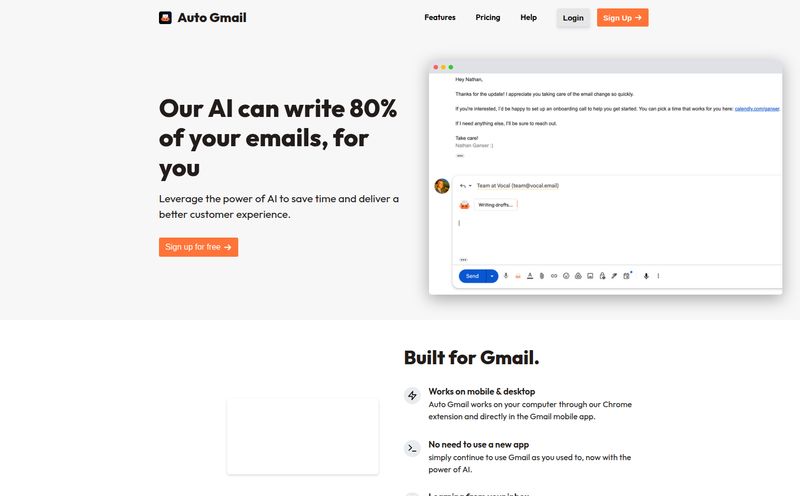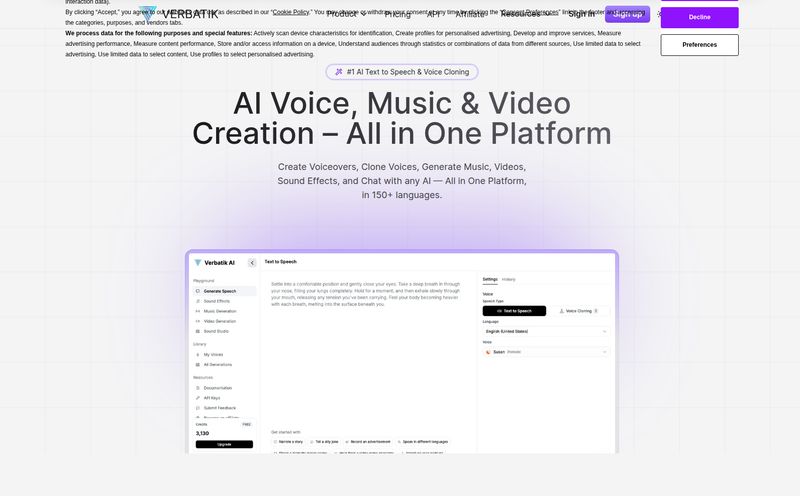I’ve been in this game a long time. SEO, traffic, conversions… I’ve seen platforms come and go. I remember the absolute nightmare of setting up early-gen chatbots. You'd spend a week mapping out conversational flows that looked like a madman's spaghetti diagram, only to have a customer ask a slightly-off-script question and watch the whole thing crash and burn. It was painful. So, when a company called Haiva lands on my radar with the claim you can build a multilingual, functional AI voice agent in under three minutes, my professional-skeptic-o-meter goes off the charts. Three minutes? C'mon.
But hey, I wouldn't be doing my job if I didn't at least kick the tires. And what I found was... well, it’s interesting. Genuinely interesting. Haiva isn't just another pretty chatbot face. It's a self-service AI platform aiming to do something fundamentally different.
So, What Exactly is Haiva Beyond the Marketing Spiel
Let's get this straight first. Haiva isn’t about building a glorified FAQ bot that can say "Hello, how can I help you?" It’s about creating AI agents. The distinction matters. An agent does things. It connects to your tools, your software, your data, and performs tasks. It’s designed for action, not just conversation.
The core idea is to empower anyone—not just a team of a dozen developers—to spin up a smart assistant for their sales or support teams. And the multilingual part? That’s not just an afterthought. We’re talking about building one agent that can then communicate in multiple languages, effectively opening up new markets without the insane overhead of hiring multilingual support staff from day one. That alone should make any operations manager's ears perk up.
This whole thing is built on Microsoft Azure, which gives it a layer of enterprise-grade credibility right out of the gate. It's not some fly-by-night startup running on a server in a garage. But the real secret sauce isn't who hosts it, but how it thinks.
The Magic Under the Hood and How Haiva Works
I’ve seen a million platforms that boast about their “powerful AI,” but that phrase has become so diluted it’s almost meaningless. With Haiva, the difference lies in its core methodology. It doesn’t just learn from a pile of documents you feed it; it learns from your applications.
API Application Training as a Different Breed of AI
This is the part that got my attention. Most AI training involves feeding the model mountains of data—help articles, product descriptions, chat logs. The AI memorizes it all and tries to spit back the right answer. Haiva’s approach is different. It focuses on API application training.
Think of it like this: traditional AI is like a librarian who has read every book in the library. You ask a question, and they tell you what the book says. Haiva is more like a master locksmith. It doesn’t need to have memorized the contents of every room; it just needs to know how to use the right key (the API) to open any door (your software). It learns how your applications function.

Visit Haiva
You connect it to your CRM, your inventory system, your booking software via their APIs, and Haiva learns the actions possible. Check stock? Process a return? Book a demo? It learns these as skills. This is a far more dynamic way of operating. The potential downside, of course, is that this approach lives and dies by the quality of your APIs. If your backend is a mess of poorly documented, inconsistent APIs, you’re going to have a bad time. Garbage in, garbage out, as they say.
Dynamic Workflows and Unified Connectors
Here’s the part that makes the "under 3 minutes" claim almost believable. Because Haiva understands the actions your software can perform, it doesn't need you to manually build a workflow. You don't have to sit there with a drag-and-drop interface connecting 'if this, then that' boxes for hours. It dynamically generates the workflow based on the user's goal. A customer wants a refund? The agent knows the steps: find the customer, check the order, process the refund via the payments API. It figures out the path on its own. It's a huge time-saver and, honestly, a massive relief for anyone who has been trapped in flowchart hell.
Putting it into Practice with Use Cases That Actually Make Sense
Theory is great, but traffic and revenue are better. So how does this translate into real-world results?
- A Sales Agent on Steroids: Imagine a potential customer on your site. They can ask a voice agent, "Do you have the blue widget in stock and can you ship it to Germany?" The Haiva agent connects to your inventory API, confirms stock, then checks your shipping API for Germany rates, and could even initiate the checkout process right in the chat. That's not a conversation; that's a sale.
- Support That Doesn't Suck: We've all been there. Waiting on hold for 20 minutes to ask a simple question. A Haiva agent can be the first line of defense. It can authenticate a user, check their account status, look up their last bill, and even perform basic actions like password resets. This frees up your human agents for the truly complex, high-touch problems.
- Global Domination (on a budget): This is the big one for me. The ability to serve customers in Spanish, French, or Japanese without having dedicated teams for each is a game-changer. You can test new markets and provide a localized experience at a fraction of the traditional cost. For any business looking to scale internationally, this is a massive advantage.
Let's Talk Turkey and The Haiva Pricing Model
Alright, the tech is cool. But how much does it cost? Haiva uses a pay-as-you-go model, which I have a love-hate relationship with. On one hand, it’s fantastic for getting started. You only pay for what you actually use, with no hefty monthly subscription fee just to keep the lights on. On the other hand, it can make budgeting a bit… unpredictable, especially if your traffic is spiky. A viral marketing campaign could suddenly mean a much larger bill than you expected.
Here’s a simplified breakdown based on their pricing page:
| Service | Cost | Notes |
|---|---|---|
| Web Chat | $0.02 / transcript | An additional $0.02 per transcript for the "insight agent" feature. |
| Web Voice | $0.03 / transcript | For voice interactions directly on your website. |
| Telephony | $0.04 / minute | For integrating with actual phone lines. |
The pricing seems reasonable, especially for the capabilities on offer. The "insight agent" is likely where they package extra analytics like sentiment analysis or trend spotting, which could be well worth the extra two cents per chat.
My Honest Take and If Haiva is Worth the Hype
So, do I believe the three-minute claim? With a caveat. If you have your APIs in order, clearly documented, and you know exactly what you want the agent to do, then yes, I can see it being incredibly fast to deploy. The heavy lifting is done by the AI's understanding of your tools, not by you manually building logic trees.
Haiva is a genuinely powerful platform for a specific type of user: a tech-forward company with a decent API infrastructure that values speed and scalability. It’s for businesses that want their AI to do something, not just talk. The multilingual features are a standout, and the dynamic workflow generation is a breath of fresh air.
It’s not a magic wand, though. It won’t fix a messy backend. But if you’ve got the right foundation, Haiva could be teh tool that lets you build a powerful, automated, and global sales and support force faster than you ever thought possible.
Frequently Asked Questions about Haiva
- How long does it really take to set up a Haiva agent?
- The "under 3 minutes" claim is for the agent creation itself. The real-time investment is in connecting your APIs first. If your APIs are ready to go, the setup is incredibly quick. If not, you'll need to sort that out first.
- Can Haiva handle languages other than English?
- Yes, absolutely. This is one of its main strengths. You design the agent's logic once, and it can then be deployed to interact with users in multiple languages.
- Do I need to be a developer to use Haiva?
- You don't need to be a hardcore coder, but you do need to understand what an API is and how to connect it. It's geared toward people who are technically comfortable, even if they aren't writing code all day. Think a product manager or a tech-savvy marketing ops person.
- How does Haiva connect to my existing software?
- It connects via APIs (Application Programming Interfaces). Haiva provides unified connectors that you point at your software's APIs, allowing it to communicate and perform actions with your tools like a CRM, e-commerce platform, or helpdesk software.
- Is the pay-as-you-go pricing good for small businesses?
- It can be. It's excellent for starting out because there's no high upfront cost. You can test the platform with minimal risk. The only thing to be mindful of is planning for costs if your usage suddenly spikes.
More Than Just Talk
In the end, my skepticism has shifted to cautious optimism. The market is flooded with AI tools that make big promises, but Haiva feels different. It's less concerned with mimicking human chit-chat and more focused on being a functional, action-oriented extension of your team. It's not just a voice; it's a pair of hands. And in the world of online business, where speed and efficiency lead to conversions, that might just be what we needed all along.



